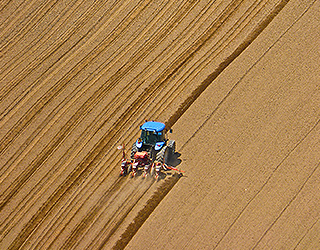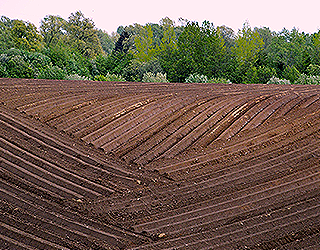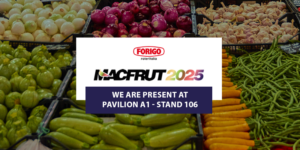News
What is Plowing? Strong points, weak points and alternative methods
News _ 30 NOVEMBER _2020
Since almost a thousand years, plowing technique has considered one of the main soil preparation procedure: rolling over the clods allows to bring the soil back to its initial structure and start with the seed bed preparation. However, how this technique should be performed? When should it be done? Which kind of benefits and drawbacks does it bring? In which manner plowing may affect the soil and the surrounding environment? In this article we will discover plowing in detail, its objective and its’ alternative methods.
What is plowing? What is it used for?
With “plowing” it’s intended that process which allows to remove horizontal clods from the soil. The clods then will be rolled over and destroyed in order to bring the soil back to its original phase, helping the passage of organic substances, providing space and nutriments to the new crop.
Usually, plowing is done at the end of the harvesting process. The aim of this technique is in fact to eliminate the weeds and most of all the residues of the previous crop, bringing them down in depth so they cannot influence the growth of the plants. In this way it’s possible to soften the soil and gradually prepare it for the next crop.

- Superficial, from 10 up to 20 cm
- Medium, from 20 up to 40 cm
- Deep, from 40 up to 60 cm
Plowing can be performed in different periods during the year, even though the best results are obtained in the mid-seasons. With autumn plowing in fact, crop residues, organic fertilizers are buried down the soil in a contextual period, with increase of rainfalls and lowering of the temperature degrees. In this regard, a lower temperature implies frosting and defrosting action, causing a quick breaking of the clods.
For what concerns springtime, plowing has mainly a prevention goal. It’s performed just before the seeding to avoid the hardening of the clods, caused by the gradual appearance of the sun and of the warm.
On the other hand, during summertime, plowing is usually reserved to clayey soil, which has particular needs (for example, becomes impractical during the heavy rain, typical of autumn season).
Which are plowing benefits?
There are various reasons because, still today, plowing is considered a very important technique for the seedbed preparation. Here below we will analyze the main advantages which can be brought by this process.
- The ideal structure of the soil is restored.
Mixing the clods, rolling them over and leave the space on the surface to a “new” field which has not been previously intensively cultivated, which helps the birth and the growth of the future new plant. It in fact, will be able to find the proper space to expand its roots.
- The new field will be waterproof and rich of oxygen. With plowing, the soil is renovated: as consequence, it increases its porosity, which is essential for the passage of water, oxygen and other organic substances. Furthermore, the residues of the previous crops, which are brought in depth by the plough, become source of nutriments for the new plant;
- There’s a strict control on weeds. Rolling up the soil also means destroying the weeds and reduce the activity of animal parasites which prevent or make more difficult the growth of the crop.
Which are plowing drawbacks?
With the technological innovation, more often plowing has become a subject of discussion for agronomists and farms. This technique in fact, brings also some disadvantages, which move in opposite direction in relation to eco-sustainability. Here below some of the drawbacks brought by plowing:
- Some damages are brought to the microflora
present in the soil. The ground is populated by microorganisms, each one with precise needs, according to their living level: on the surface are more present aerobic microorganisms. which require a large quantity of oxygen to survive; going down in depth we find bacteria and anaerobic fungus, which suffer if get in contact with the air. It’s clear then that rolling up the soil means affecting the equilibrium of the microflora: over time, this provokes huge damages, with consequence a loss of fertility of the field;
- Creation of the hard pan layer. The huge weight of the plough compresses the soil and creates a layer – so called “hard pan layer”- which over time, becomes more and more deep. This layer doesn’t allow both air and water passage and makes more difficult the growth of the roots of the new plant, causing progressive loss of fertility of the soil.
- Increasing number of working passages. Plowing leaves big clods on the ground surface. For this reason, it will be necessary to perform other techniques to prepare optimally the soil. Those will crumble the clods and make them flaky, ready for another crop. This procedure though means a slowdown of all operations, with consequence an increase of costs;
- Higher energetic and economic consumption. Complementary jobs involve higher costs in terms of fuel and a higher environmental impact. Furthermore, plows need a huge amount of traction force and, as consequence, specific tractors, which may reach very high costs.
Which are the alternative methods to plowing?
Above all, considering “sustainable agriculture” principle, as time passed by, different alternative methods have been invented. Their main objective is to not work too deep if not necessary, limiting by consequence the intensive use of polluting fuel.
The first method is called “seeding on hard soil” or “direct seeding”. It is mostly used for cereal crops and consist in seeding on soil still covered by residues of the previous crop or by “cover crops”. In this way, various phases of mechanical tillage are eliminated, increasing the natural fertility of the soil.

Especially, Forigo Roter Italia stone buriers are able to bury previous crops residues, stones and cover crops, allowing at the same time a good refinement of the soil. This means that after the passage of the stone buriers, the ground will not be divided into big clods anymore, it will be evenly crumbled instead, ready to host a new crop.
The new field will show all the benefits as if been tilled by a plow: it will be optimally structured and perfectly waterproof, granting the equilibrium of its biodiversity. Furthermore, working on surface, stone buriers will avoid the risk of creation of the hard pan layer, keeping the soil fertile as time passes by. All of these benefits can be brought without exceeding the fuel costs and without causing a huge environmental impact.
Conclusion
Plowing is still one of the most used tilling technique, also today. It has however, two faces: on one side we find a better weed control and a total restoration of the ideal soil structure, making it ready for the next crop. On the other side, the use of tractors with higher torque than normal, result in an increment of machines and fuel costs, as well as creating an unbalance of the biodiversity of the ground.
The alternative techniques have been invented precisely for avoiding the disadvantages brought by plowing; among those we find the direct seeding and the minimum tillage performed by the stone buriers.
We hope this article has been helpful for you and your business. If you need further information about plowing, do not hesitate to contact us; Forigo Roter Italia team will be at your disposal to clarify any doubt.

Research and Development Division of Forigo Roteritalia. Team of experts engaged in the study and analysis of the main agricultural and horticultural techniques used today. Knowledge combined with competence are the starting point for continuous improvement in a scenario of innovation and technological development.
Previous Exhibitions
30 MARCH 2025
Forigo at Agriumbria 2025: quality in soil preparation



 Mixing the clods, rolling them over and leave the space on the surface to a “new” field which has not been previously intensively cultivated, which helps the birth and the growth of the future new plant. It in fact, will be able to find the proper space to expand its roots.
Mixing the clods, rolling them over and leave the space on the surface to a “new” field which has not been previously intensively cultivated, which helps the birth and the growth of the future new plant. It in fact, will be able to find the proper space to expand its roots. present in the soil. The ground is populated by microorganisms, each one with precise needs, according to their living level: on the surface are more present aerobic microorganisms. which require a large quantity of oxygen to survive; going down in depth we find bacteria and anaerobic fungus, which suffer if get in contact with the air. It’s clear then that rolling up the soil means affecting the equilibrium of the microflora: over time, this provokes huge damages, with consequence a loss of fertility of the field;
present in the soil. The ground is populated by microorganisms, each one with precise needs, according to their living level: on the surface are more present aerobic microorganisms. which require a large quantity of oxygen to survive; going down in depth we find bacteria and anaerobic fungus, which suffer if get in contact with the air. It’s clear then that rolling up the soil means affecting the equilibrium of the microflora: over time, this provokes huge damages, with consequence a loss of fertility of the field;







